We may not have the course you’re looking for. If you enquire or give us a call on + 1-866 272 8822 and speak to our training experts, we may still be able to help with your training requirements.
Training Outcomes Within Your Budget!
We ensure quality, budget-alignment, and timely delivery by our expert instructors.

The significance of robust network security becomes more pronounced in today's digitally connected world. Organisations must navigate the complexities of safeguarding sensitive data and thwarting potential threats. In this era of heightened cyber risks, Network Security professionals play a pivotal role in fortifying defences. Explore the top Network Security Interview Questions and answers for both fresher and experienced candidates to help them secure their dream jobs.
Table of Contents
1) Network Security Interview Questions and Answers
a) What is the internet?
b) What is a switch in networking?
c) What is pipelining?
d) What is a network?
e) What is the hub in networking?
2) Network Security Interview Questions and Answers for Experienced
3) Conclusion
Network Security Interview Questions and Answers
Below are the Top 30 Network Security Interview Questions and Answers for your extensive preparation. Have a look and prepare well!
Q1) What is the internet?
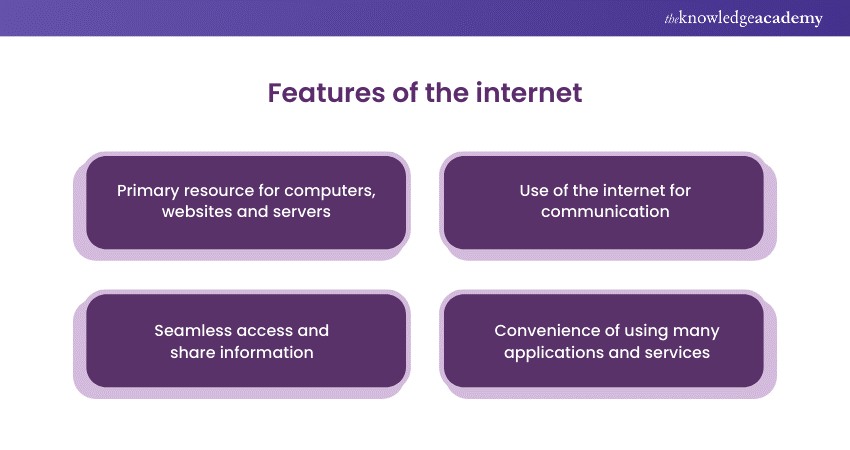
The Internet is a global network of computers and several other electronic devices allowing easy data sharing and transmission across huge distances. It operates through a standardised set of protocols (rules for data transmission), which is the fundamental of Transmission Control Protocol (TCP) and the Internet Protocol (IP). These protocols ensure that data sent across the network is divided into packets, routed from the source to the destination, and reassembled into the original message.
Prepare for your next network engineering interview with these essential IPv6 questions!
Q2) What is a switch in networking?
Network devices, particularly switches, serve as connectors within a local area network (LAN), facilitating data exchange between connected devices. The primary function of a switch is to transmit data packets exclusively between devices linked to the same port, abstaining from forwarding data between ports on diverse devices or to external networks.
In contrast, a router plays a distinct role by directing data packets across various networks. The precision of a switch lies in its targeted delivery, ensuring that data is sent solely to the designated device, be it another switch, a router, or a user's computer. This emphasis on directed data transmission distinguishes switches from routers in network functionality. The selective nature of switch communication enhances the efficiency and security of data transfer within local networks.
Stay ahead of the curve – Switch to IPv6 and enhance your network!
Q3) What is pipelining?
Pipelining, in the realm of Software Development, entails the simultaneous creation and testing of multiple software program iterations. This approach bears semblance to parallel processing but operates more nuancedly. Rather than crafting a singular program, the methodology involves the concurrent development of multiple parallel programs. The outcome is a streamlined process, allowing the creation of a new program version within a matter of hours, as opposed to the extended timelines of weeks or even months.
By employing pipelining, developers concurrently work on multiple versions of the software program, each undergoing individual testing and development. Once all the iterations are finalised, the combined result is executed simultaneously, giving rise to the ultimate version of the program. This innovative approach expedites the software development life cycle, providing a more efficient and agile methodology for creating and refining software applications.
Upgrade your networking knowledge—learn the essential distinctions between IPv4 and IPv6 today.
Q4) What is a network?
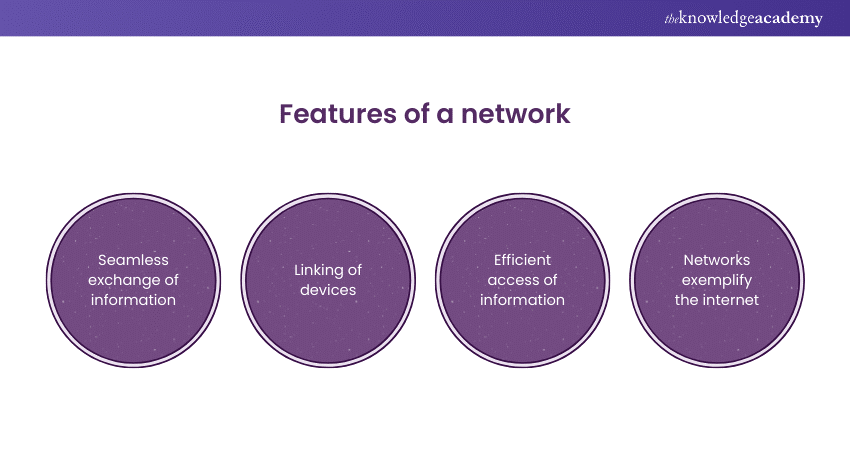
A network constitutes a collection of interconnected computers and devices, fostering the seamless exchange of information between them. It involves the process of linking these devices, enabling communication. An integral facet of networking lies in the capacity to share data, exemplified on a grand scale by the expansive Internet. Through data sharing, information access becomes more efficient and expeditious. However, networking carries inherent risks, with security emerging as a paramount concern. The interconnected nature of networks introduces uncertainties, such as the potential for hacking leading to data loss or identity theft, underscoring the need for robust security measures.
Uncover the power of Cognitive Threat Analytics and strengthen your cybersecurity defense.
Q5) What is a hub in networking?
Hubs function as network nodes responsible for interconnecting other nodes, often serving as the initial point of contact for new additions to the network. Additionally, they act as the entry point for external resources such as software updates and customer service. Ideally suited for uncomplicated local area network setups, hubs lack the capacity for advanced network services and routing capabilities. Operating by indiscriminately forwarding Ethernet frames across all ports, hubs are colloquially referred to as "dumb switches."
Although network hubs once had a competitive edge in terms of lower prices, their limited capabilities and scalability rendered them less favourable than switches. As switch prices decreased in the early to mid-2000s, hubs gradually fell out of widespread use. While less prevalent today, network hubs find niche applications, continuing to provide a straightforward networking solution.
Q6) What is a protocol?
A protocol comprises a set of regulations dictating the interactions between two or more entities, providing guidelines on how data should be communicated between them. These rules are instrumental in governing data flow, particularly evident in activities like sending emails or transferring files.
More importantly, the HTTP protocol stands out as a prevalent example, outlining the procedures for data exchange between a web server and a web browser. Widely employed by numerous websites, HTTP facilitates the transfer of various data types, including images, videos, and text.
Explore the different IPv6 address types and expand your networking expertise today!
Q7) What is an Intranet?
An Intranet functions as a restricted network exclusive to specific organisations, serving as an internal communication platform accessible solely to its employees. It facilitates the interaction of computers from various entities within a closed system. As a private network, an Intranet permits access exclusively to its members and staff. Numerous businesses maintain their dedicated Intranet networks, limiting accessibility to employees and clients. The closed nature of an intranet ensures that information remains within the network, safeguarding data from external exposure.
Q8) What is a Simplex operation in networking?
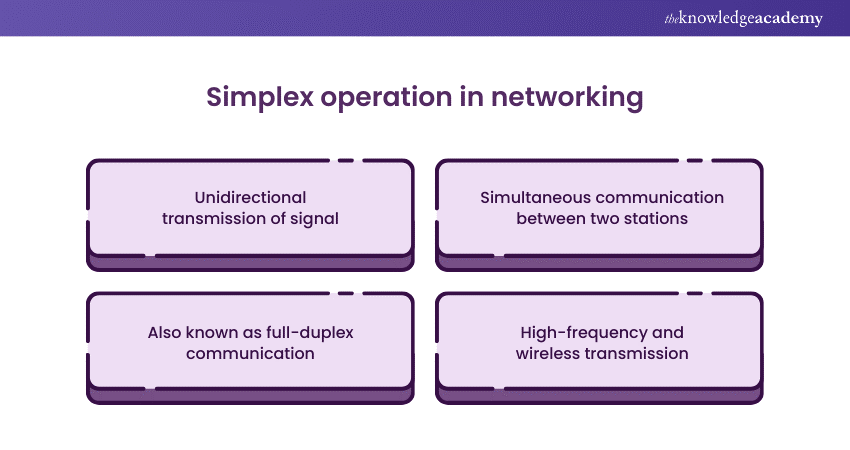
In Simplex operation, a singular signal is transmitted unidirectionally, consistently moving in the same direction. Both the transmitter and receiver function on identical frequencies. When two stations communicate with each other simultaneously on the same frequency, the mode is referred to as half-duplex, commonly known as Simplex.
However, in scenarios where Simplex or half-duplex operation may not suffice to achieve the required communication range, especially in high-frequency and microwave wireless transmissions, wireless repeaters are introduced. These repeaters serve to extend the effective range by strategically positioned relay points.
Q9) What is MAN in networking?
A Metropolitan Area Network (MAN) interlinks computers situated in two or more cities, overcoming physical distances to offer high-speed connectivity. Operating on a broad geographic scale, a MAN can serve as an Internet Service Provider (ISP) and supports connection speeds ranging from Mbps. Establishing and maintaining a MAN network is challenging due to its inherent complexity.
More importantly, MANs exhibit lower reliability and increased congestion, accompanied by higher costs. The control over MANs may or may not be centralised within a single organisation. While data transfers within MANs are swift, the volume of data transferred is comparatively lower.
Modems, along with wires and cables, serve as the mediums for data transmission within a MAN. Often, a MAN constitutes a segment of a telephone company network, providing DSL lines to customers or linking to a city's cable TV network.
Q10) What is LAN in networking?
Local Area Networks (LANs) facilitate the exchange of data, tools, and programs between personal computers and workstations. A network of switches interconnects these devices to enable seamless sharing within the local area. Employing private addressing alongside the TCP/IP protocol, LANs are established, and a router connects the local network to the broader internet.
The transmission capacity of data is constrained by the number of connected computers, necessitating affordable and high-speed hardware such as hubs, network adapters, and Ethernet cables. Despite their limited scope, typically confined to spaces like office buildings, homes, hospitals, and schools, LANs, being privately owned, require cost-effective and efficient components.
Q11) What is Web Security?
Ensuring the security of a network or computer system involves safeguarding it against potential damage or theft of software, hardware, and data. Protection extends to preventing the misdirection or disruption of services within computer systems.
The realm of website protection, termed web security, encompasses defence measures for cloud services, web applications, and virtual private networks (VPNs). These protective measures are essential for businesses relying on computer systems, as compromised websites or manipulated software can lead to disruptions in operations, potentially bringing the entire network to a standstill and impacting business continuity.
Q12) What is WAN in networking?
Wide Area Networks (WANs), also recognised as networks covering extensive geographical areas, link Local Area Networks (LANs) through telephone lines and radio waves. While these networks may span across a single country or state, they are commonly utilised by enterprises, governmental agencies, and various organisations. Operating WANs is both fast and costly.
The design and maintenance of WANs pose challenges, with two primary types, namely switched WAN and point-to-point WAN. In comparison to Metropolitan Area Networks (MANs), WANs exhibit less fault tolerance and heightened network congestion. Communication within WANs relies on telephone lines or satellite links, exposing them to potential long-distance noise and errors.
Craft your ideal IT strategy for your network solutions by signing up for our IT Support and Solution Training now!
Q13) What is a Firewall in networking?
A firewall meticulously scrutinises both incoming and outgoing network traffic, applying a set of security rules to determine whether to accept, reject, or drop packets. When a rule matches, it triggers an action on the network traffic.
For instance, a firewall might enforce rules that prohibit HR department employees from accessing data from a code server while allowing system administrators access to both HR and technical data. Combining rules enables customisation based on organisational security and efficiency requirements.
Operating in two phases, a firewall blocks both incoming and outgoing network connections, emphasising the importance of setting rules to enhance security by restricting unwanted communication, particularly for outgoing connections. ICMP messages, common in incoming traffic, are identified by type rather than port numbers.
Q14) What is Mobile device security?
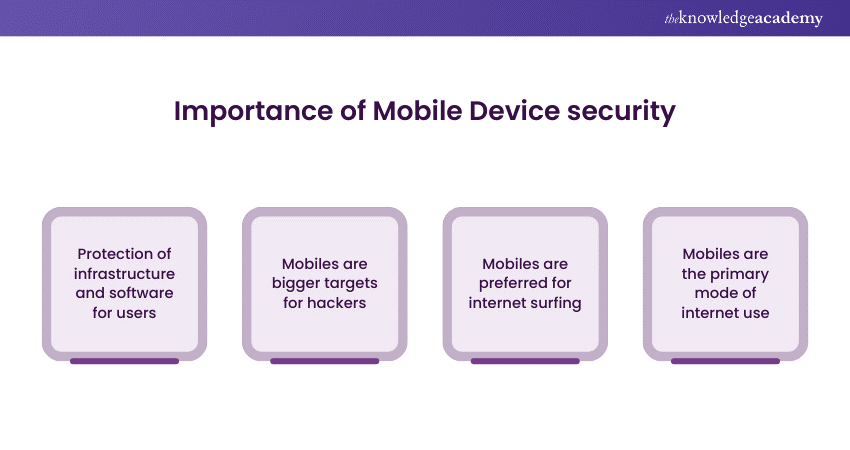
Mobile security protects the infrastructure, software, and strategy behind mobile devices that travel with users. Mobile devices, including smartphones, tablets, and laptops, must be protected from cyberattacks. Mobile devices are becoming more popular than their stationary counterparts, so they are becoming bigger targets for hackers.
As more workers and consumers use mobile devices for internet browsing, mobile devices have become an integral part of their daily lives. Mobile devices have evolved from desktop-only internet browsers to being the preferred internet browsing method.
Moreover, laptop-toting travellers are now the exception rather than the norm. Browsing on mobile devices has become the primary form of internet usage, and mobile web traffic has overtaken desktop internet usage.
Q15) What is Wireless security?
Wireless networks offer users numerous advantages, yet their operation can be highly intricate. Unlike data packets transmitted through wired connections, wireless data lacks the assurance of being secure from eavesdroppers.
To establish a secure wireless connection, attention should be directed towards key areas: identifying the wireless network's endpoints and end users, safeguarding data packets from interception by intermediaries, ensuring the integrity of wireless data packets, and preserving the anonymity of such packets.
Network Security Interview Questions and Answers for Experienced candidates
Below are the most commonly asked questions and their answers for experienced candidates:
Q16) What is network encryption, and how does it work?
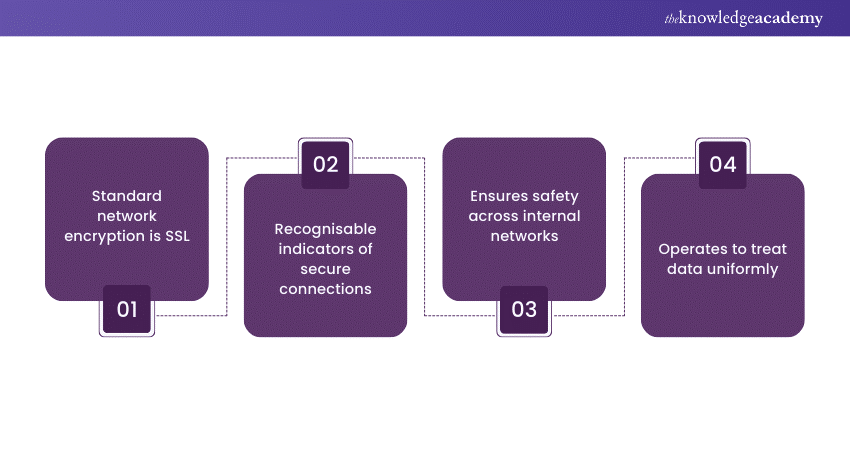
SSL, also known as Transport Layer Security (TLS), serves as the standard network protection technology symbolised by the padlock in a user's internet browser. Widely adopted globally, SSL and Layer 2 VPN (Virtual Layer VPN) have become recognisable indicators of secure connections. Businesses leverage these standards to ensure safety across their internal networks, backbone networks, and Virtual Private Networks (VPNs).
At the network level, data encryption, represented by SSL, provides a foundational layer of security. However, it operates as a broad measure, often treating all data equally. Despite its effectiveness, network traffic patterns can reveal valuable information to potential attackers, emphasising the need for a comprehensive data security strategy that addresses risks associated with data generation and consumption for optimal protection.
Q17) What is IPS in Network Security?
An Intrusion Protection System (IPS) is a Network Security tool, either in hardware or software form, designed to monitor a network for unlawful activities. In the event of such activities, the IPS takes proactive measures, such as blocking or dropping the threat, while also generating reports.
Compared to an Intrusion Prevention System (IPS), an Intrusion Detection System (IDS) is more sophisticated as it solely detects malicious activities without taking immediate action. Often integrated into Next-generation Firewalls (NGFW) or Unified Threat Management (UTM) solutions, IPS is adept at efficiently examining substantial traffic volumes without compromising network performance, making it one of the most prevalent Network Security solutions.
Configure network protocols for your IT architecture by signing up for our VPN Training now!
Q18) What are the Administrator privileges?
Administrative Privileges pertain to the permissions bestowed upon users by administrators, empowering them to create, delete, and alter items and settings. These privileges are essential for executing various system modifications, including software installations and adjustments to network settings. The absence of administrative privileges limits users from performing crucial actions, such as upgrading a program, even if they can still use it.
Q19) What are the potential consequences of a Network Security attack for an organisation?
A Network Security attack has the potential to cause irreparable harm to an organisation, leading to various adverse consequences, including:
a) Compromised sensitive information and proprietary data
b) Decreased profits
c) Diminished shareholder value
d) Impaired reputation
e) Erosion of brand value
f) Weakened trust from customers
Q20) What are the different types of Network Security tools?
Various Network Security tools encompass:
a) Access management
b) Antivirus and anti-malware applications
c) Application security measures
d) Data Loss Prevention (DLP)
e) Email security protocols
f) Firewall solutions
g) Intrusion prevention systems
h) Security measures for mobile devices
i) Host-based Intrusion Detection System (HIDS)
j) Network Intrusion Detection System (NIDS)
k) Behavioural analytics tools
l) Network segmentation strategies
m) Virtual Private Network (VPN) services
n) Web security protocols
o) Wireless security measures
Q21) Describe adware.
Adware, a type of malware, is responsible for presenting undesirable advertisements on your computers or mobile devices. Often installed without the user's knowledge, adware becomes active during the installation of legitimate software. While certain pop-up windows aim to deliver personalised ads, others simply showcase advertisements without collecting data or compromising your computer. It's crucial to note that adware can expose you to computer viruses if it utilises advertisement links to direct you to unsafe websites and infected pages.
Q22) How is phishing carried out?
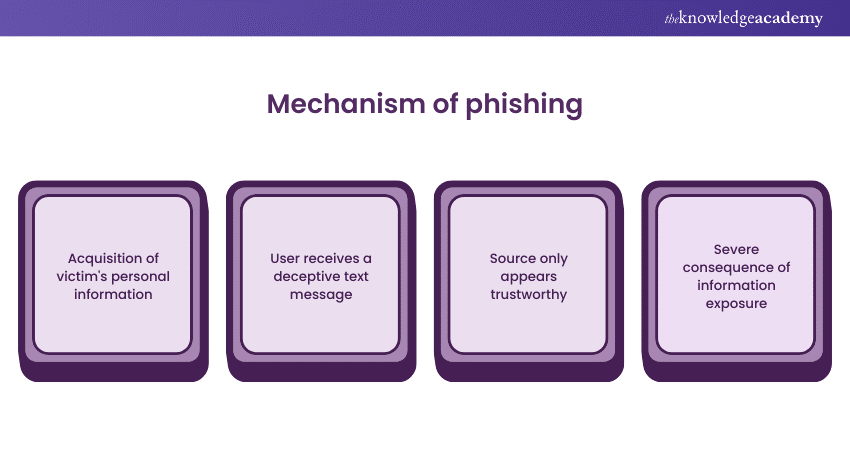
Phishing, a form of social engineering, enables hackers to acquire a victim's personal information, such as login credentials and credit card details. The attack typically commences with a deceptive text message, email, or other forms of communication appearing to be from a reputable source. Victims are lured into opening these deceptive emails or text messages, leading to severe consequences as sensitive information is exposed. Beyond data theft, hackers can deploy viruses to compromise computers and manipulate victims into engaging in activities like money laundering.
Q23) Why would you use a proxy firewall?
A proxy firewall protects network resources by screening packets at the application layer instead of the network or transport levels. However, its use can lead to application lag and reduced functionality.
Contrary to traditional firewalls, which neglect traffic decryption and application protocol traffic inspection, IPSs and antivirus programs cover only a limited portion of the threat landscape. Proxy servers act as intermediaries between two networks, facilitating the secure transfer of data between computers and servers on the internet.
To defend against cyberterrorism and unauthorised access, a proxy server filters, manages, blocks, archives, and controls requests from devices. It determines permitted and restricted traffic, actively seeking indicators of malware incursions or cyber threats.
Q24) What's traceroute?
Administrators employ network diagnostic tools like traceroute to trace the path of data packets from source to destination, identifying connectivity issues. The command is TRACERT on Windows and traceroute on Linux or Mac. Both functions reveal the data's path through a network to a specific IP server, listing each intermediary device's name and IP address.
Moreover, Traceroute provides round-trip time (RTT) and device names. While it helps locate problems, it doesn't confirm their existence. To determine issues, Ping is useful. If a website loads slowly, traceroute can pinpoint delays by identifying locations with the most significant delays.
Q25) Tell us about the CIA Triad in Network Security.
Abbreviated as CIA, which stands for ‘Confidentiality, Integrity, and Availability’, the CIA Triad is a prominent framework exemplifying how privacy policies should be maintained within businesses. Security professionals assess threats by considering their potential impact on an organisation's assets' availability, confidentiality, and integrity.
A network can only be deemed secure when it incorporates all three essential elements of the CIA Triad:
a) Confidentiality involves the deliberate effort to keep an organisation's data private and undisclosed, preventing unauthorised access while granting access to approved individuals.
b) Integrity ensures the accuracy and reliability of information.
c) Availability mandates constant access to systems, programs, and data for authorised users, ensuring resources are accessible at all times.
Create and configure your proxy server by signing up for our Apache Web Server Training now!
Q26) What are the most effective measures against a login brute force attack?
Three primary methods can be employed to defend against brute-force login attempts. Initially, there's an account lockout mechanism wherein compromised accounts are disabled and remain so until reactivated by the administrator. The subsequent approach is the progressive delay defence, where the account remains locked for a designated period after multiple failed login attempts. The final step involves the challenge-response test, which hinders automated submissions on the login page.
Q27) Define Ransomware.
Ransomware often involves encrypting or encoding data, and the attacker demands a ransom payment from the victim for its release. The ransom demand typically comes with a deadline, and if the victim fails to make a timely payment, the data may be permanently lost, or the ransom amount may increase. Ransomware attacks are widespread, affecting businesses across Europe and North America.
Targets of these attacks vary, encompassing both individuals and businesses. Government organisations, such as the No More Ransom Project and the FBI, caution against paying the ransom to disrupt the ransomware cycle. Additionally, there's a likelihood that 50 per cent of those who pay the ransom might become ransomware targets again, especially if the infection persists within the computer system.
Q28) With regards to Network Security, what does ‘AAA’ mean?
AAA stands for Authentication, Authorisation, and Accounting, encompassing the protocols governing network access. This system regulates user access, enforces rules, and monitors all network activities. Radius and Diameter are two network protocols that support AAA.
Moreover, Authentication establishes a user's eligibility to use the system and network, requiring a valid username and password. Authorisation defines access rights, ensuring that users can only access specific data based on their position within the company. Accounting plays a role in compiling a record of all network activities for every user.
Q29) Give some examples of Shadow IT.
Shadow IT encompasses all IT-related transactions and activities that occur without the knowledge of the IT department, conducted in adherence to the business's established rules. The examples below are categorised into various groups:
1) Cloud services, encompassing SaaS, IaaS, and PaaS.
2) Hardware covering computers, tablets, laptops, flash drives, smartphones, etc.
3) Packaged Software.
4) Productivity tools like Slack and Trello.
5) Communication programs such as VoIP and Skype.
Q30) List the basic principles of Network Security.
A comprehensive framework of guidelines and regulations for safeguarding network access, coupled with suitable hardware and software solutions, constitutes Network Security. It encompasses all strategies employed to protect a network and its data from intrusions and potential threats.
Moreover, Network Security involves various measures, including traffic monitoring, virus detection and elimination, data encryption, and access control for both computer networks and applications. An effective Network Security plan serves to protect client data, uphold shared data confidentiality, and ensure consistent network performance.
It not only minimises overhead costs but also shields companies from the financial repercussions of data breaches and other security lapses. To counter cyber threats, businesses must ensure that users have authorised access to data, systems, and applications.
Implement network protocols for secure data transfer by signing up for our Introduction to Networking Training now!
Conclusion
In conclusion, a robust Network Security plan is paramount in safeguarding data, ensuring confidentiality, and maintaining optimal network performance. To fortify defences, businesses must address authorised access and deploy effective measures. Preparing for Network Security Interview Questions is essential, emphasising the significance of staying informed and vigilant in the ever-evolving cybersecurity landscape.
Frequently Asked Questions
Upcoming IT Infrastructure & Networking Resources Batches & Dates
Date
 Introduction to System and Network Security
Introduction to System and Network Security
Fri 10th Jan 2025
Fri 14th Feb 2025
Fri 11th Apr 2025
Fri 23rd May 2025
Fri 8th Aug 2025
Fri 26th Sep 2025
Fri 21st Nov 2025







 Top Rated Course
Top Rated Course



 If you wish to make any changes to your course, please
If you wish to make any changes to your course, please


